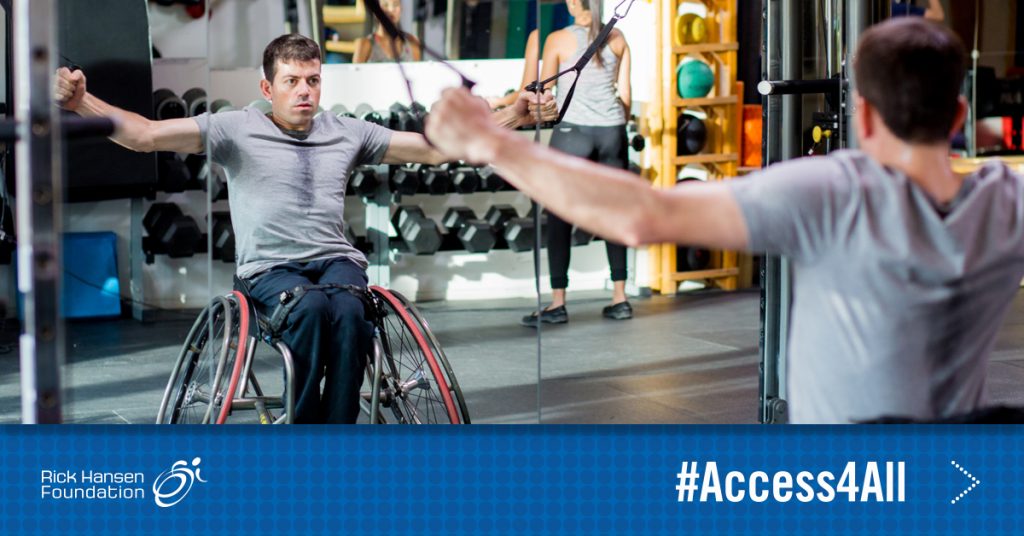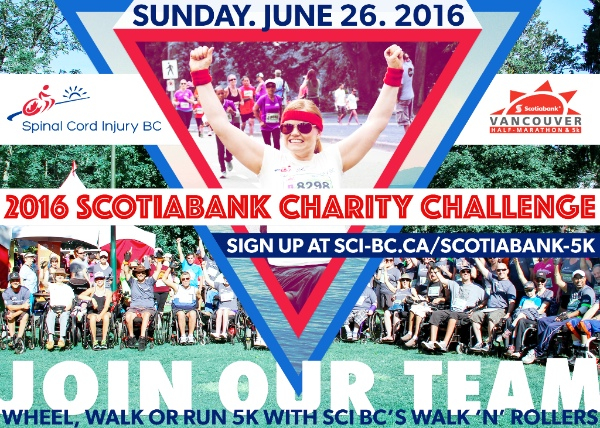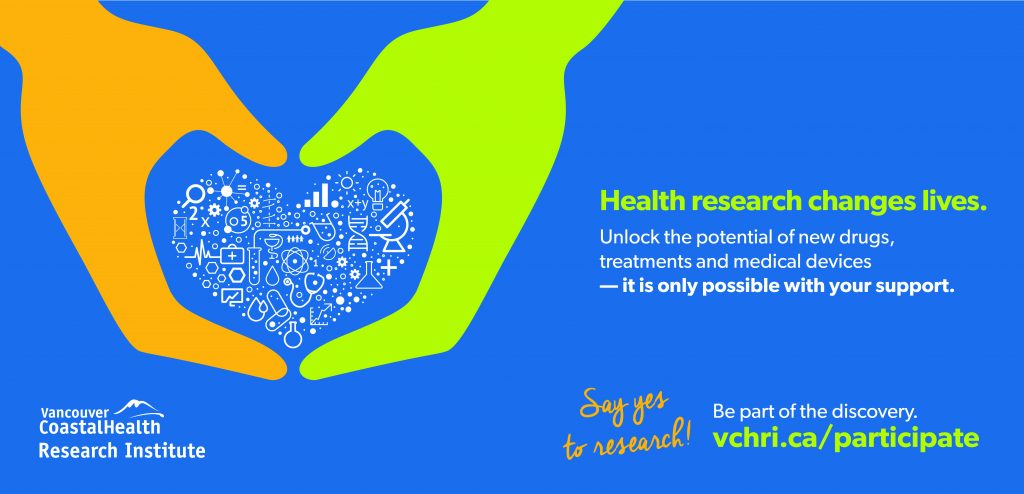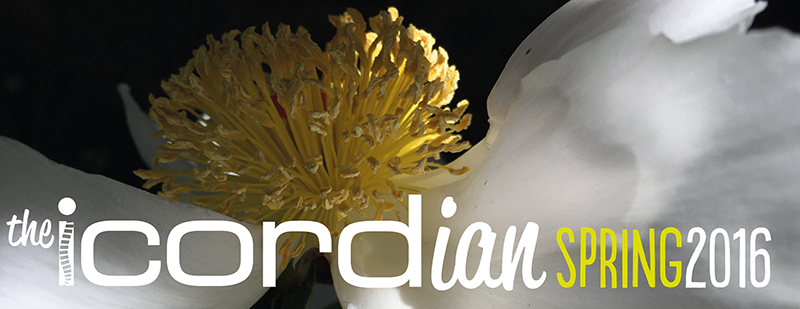

In this issue, we tell you about some interesting new SCI research, introduce you to one researcher who’s just joined ICORD and one who’s just leaving us, report on our 13th Annual Research Meeting, and tell you about a super-awesome volunteer. Plus: summer students, partner news, and some interesting events to add to your calendar.

In April, ICORD had the pleasure of welcoming its newest Principal Investigator into the Blusson Spinal Cord Centre.
Dr. David Granville and his team moved their lab here from St. Paul’s Hospital to continue their research on tissue injury and wound healing.
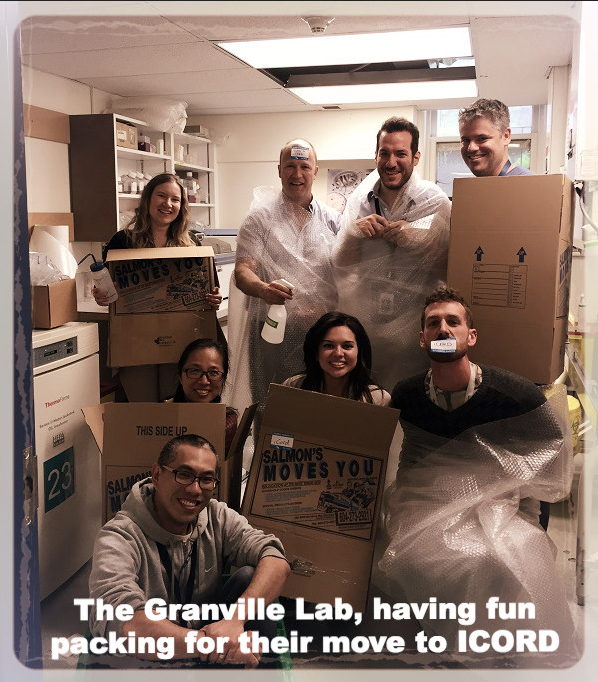 Dr. Granville’s team will be expanding on the work it has done on pressure ulcers with the Rick Hansen Institute and looks forward to applying its expertise in Granzymes to areas related to spinal cord injury. Granzymes are a type of enzyme, a serine protease, that Dr. Granville has identified as a major hindrance to normal tissue repair.
Dr. Granville’s team will be expanding on the work it has done on pressure ulcers with the Rick Hansen Institute and looks forward to applying its expertise in Granzymes to areas related to spinal cord injury. Granzymes are a type of enzyme, a serine protease, that Dr. Granville has identified as a major hindrance to normal tissue repair.
“Because this enzyme is coming up in the literature as a factor in neuronal damage, we think there could be great potential for collaborations with Drs. Tetzlaff and Kwon to learn about the role of Granzyme B in spinal cord repair, and how it contributes to demyelination in the context of multiple sclerosis with Dr. Moore’s team,” says Dr. Granville. “I am also of course very excited to combine forces with Drs. Ghahary, Jalili and others in their group on the wound healing front!”
Much of Dr. Granville’s latest work is built upon his identification of the role of Granzymes (Granule-secreted enzymes) in the pathogenesis of conditions associated with impaired healing and inflammation, including pressure and diabetic ulcers, aneurysms, nerve damage, vascular dysfunction, and burn injury.
Granzymes are protein-degrading enzymes that the immune system can use to target and eliminate unwanted cells in the body, but their accumulation in wounds can damage the extracellular matrix that is required for healing to occur. Dr. Granville likens its function to a termite.
“If you think of drywall as skin cells, behind that you have the two-by-fours and brackets, which would be the extracellular matrix. The Granzymes are acting like a termite, eating away at those two-by-fours and brackets, thereby taking away any structure for the drywall to adhere to,” he explains.
 Dr. Granville made waves in international media in 2014 when he published a paper in Aging Cell, which identified the role of Granzyme B in skin damage caused by sun exposure, which explained how this enzyme contributed to collagen breakdown in the skin.
Dr. Granville made waves in international media in 2014 when he published a paper in Aging Cell, which identified the role of Granzyme B in skin damage caused by sun exposure, which explained how this enzyme contributed to collagen breakdown in the skin.
Prior to becoming a Professor in the Department of Pathology and Laboratory Medicine at the University of British Columbia, Dr. Granville worked at QLT Inc., where his research supported the development and approval of Visudyne® as the first treatment for age-related macular degeneration, the leading cause of blindness in the elderly. In 2001, Dr. Granville relocated to the Scripps Research Institute in La Jolla, California, where his research identified a novel therapeutic approach for attenuating ischemia and reperfusion injury. His work has garnered him numerous awards and has resulted in the filing of 30 patents since joining UBC, of which, his trainees are inventors on all of them.
When he’s not in the lab, Dr. Granville is often occupied with athletics. In the spring, he is a javelin coach at the Coquitlam Cheetahs Track and Field Club. He also coaches soccer, though it’s rugby that’s “almost like a religion” to him, which he attributes to his Welsh heritage. One of the highlights of this year was his seeing Wales defeat Scotland in the Six Nations Rugby Championship.
As Dr. Granville begins his time with ICORD, he is focusing on translating his findings and research on Granzymes into therapies that can help repair non-healing wounds, such as pressure ulcers, which are a serious condition for many people with SCI.
And he and his team are eager to start work among their new labmates. “Moving into the ICORD has been a great experience so far! The community both within the centre and the extended VCH research network have been extremely welcoming in making our lab feel right at home,” says Cameron Oram, a Masters student with Dr. Granville. “We’re all excited to learn as much as we can from the other researchers and trainees here.”

In a study done here at ICORD, neuroscientists have shown that uninjured nerve cells take over the function of injured nerve cells following SCI.
The study, published on April 6 in the prestigious Journal of Neuroscience, clearly demonstrates that even a very small number of uninjured nerve cells in the spinal cord can take over the function of nerve cells damaged by SCI. Scientists have long suspected that this 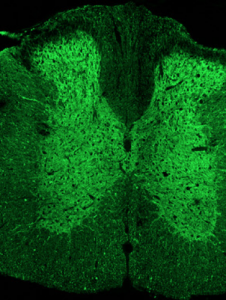 happens after SCI, but it hasn’t been conclusively proven until this study.
happens after SCI, but it hasn’t been conclusively proven until this study.
Muscles and movement are controlled by nerve cells in the brain that project to the spinal cord. After SCI, these nerve cells are damaged, leading to paralysis. However, in some individuals with SCI, spontaneous recovery of motor function can occur. How this recovery occurs is poorly understood, but understanding it better could provide new targets for therapy.
Brett Hilton, a PhD student with ICORD Director and UBC professor Dr. Wolfram Tetzlaff, investigated the role of a specific nerve pathway, called the dorsolateral corticospinal tract, in bringing about spontaneous recovery following SCI. Using rodent models, they demonstrated that while this pathway has a relatively minor role in uninjured or healthy adults, it is able to substantiate significant recovery after a partial SCI that spares this tract.
“This research shows us that we should focus on uninjured neurons as a target for therapy,” said Hilton. “Of course more work is needed, but as most SCI in humans are incomplete, and our work shows—in rodents at least—that even very small spared tracts can mediate recovery, this may be a promising target for therapeutic intervention in humans.”
Click here to read more.

ICORD researchers provided some expert opinions on a news story in April paper published in Nature. Researchers at Ohio State University in Columbus used a surgically-implanted device to record the brain activity of a study participant with quadriplegia, which then connected to a neuromuscular electric stimulation device on the participant’s wrist (see illustration). After 15 months of training, the participant, who sustained a cervical spinal cord injury four years ago, was able to use the brain-interface system to regain the ability to move his wrist and fingers and perform a number of simple tasks, including playing a video game.
ICORD’s Director, Dr. Wolfram Tetzlaff, was interviewed by CBC’s The National about his thoughts on the study. He estimated it will take a decade or two before the latest approach becomes a widespread clinical treatment. He noted that the challenge will be getting a good quality signal from the brain because of scarring, death of nerve cells and the breakdown of the electrode itself over time. “The alternative to these neural bridges would be a biological cure, for example to get the nerve fibres to regenerate,” he told CBC. “It would be much nicer to not have to get an implanted device into the brain, which at the moment is rather invasive and has complications.”
Prinicipal Investigator Dr. John Kramer spoke to Kirk LaPointe on Roundhouse Radio on the same topic, and Dr. Jaimie Borisoff also offered his opinion.
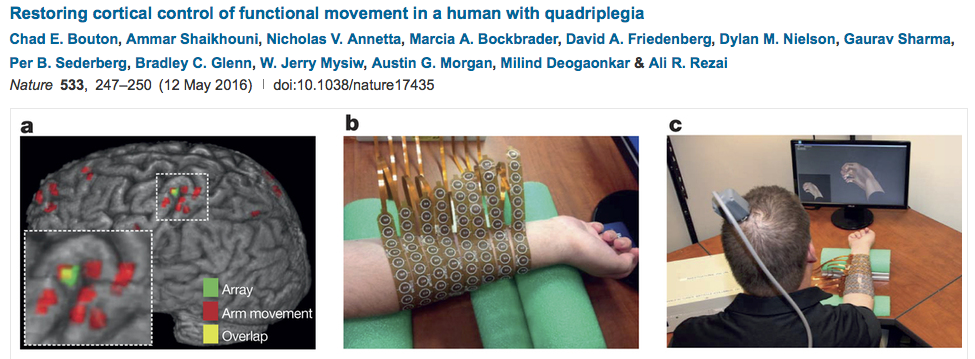
 One of the points that Dr. Kramer made in his radio interview is that this type of study is incredibly expensive.
One of the points that Dr. Kramer made in his radio interview is that this type of study is incredibly expensive.
Finding resources for research is a continuous task for principal investigators, which takes the time and work of a team of people. The costs to run a lab at ICORD can amount to hundreds of thousands of dollars a year. As translational research is one of ICORD’s main goals, the importance of funding resources such as the Blusson Integrated Cures Partnership is crucial.
The U.S. Department of Health & Human Services estimates that bringing a central nervous system drug through the Food and Drug Administration’s approval process can cost more than $50 million and take between ten and fifteen years.
Projects such as the one at Ohio State University highlight the importance of dedicated financial resources to keep this kind of science viable. This four-year project was not only the result of the commitment of the participant and researchers, but also nearly $US10 million in funding from Ohio State University’s Batelle Center for Science and Technology with an additional $US1 million from the university. This doesn’t account for the infrastructure already in place before the study began or the amount of money needed to develop the research further.
“Battelle believes it will take seven-digit funding (tens of millions of dollars) to continue research and development toward products that could emerge from this base technology system and demonstration,” says Eileen Scahill, a OSU spokesperson.

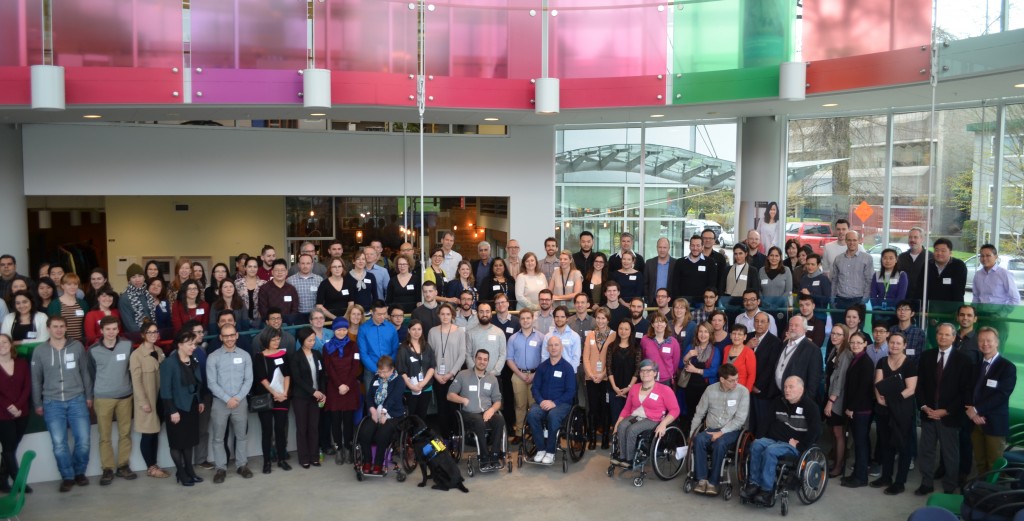
ICORD’s thirteenth Annual Research Meeting (ARM) this past March was a great success, starting on March 7 with the Robot Revolution community talk on the use of exoskeletons in SCI rehabilitation, co-hosted by SCI-BC. If you missed it, you can watch the video here. On March 8, we heard a plenary talk by Dr. Dalton Dietrich from the Miami Project to Cure Paralysis, followed by the first of two lively poster sessions and our opening reception. March 9 was a full day of talks by ICORD researchers as well as a plenary lecture by Dr. Jaynie Yang from the University of Alberta and a second poster session. This year’s meeting set a record for the highest number of research posters ever presented at an ARM. Click here to learn more.

When you meet Kyle Gieni, the soft-spoken and laid-back gentleman might not strike you as one of the most energetic people in the SCI community, but the athlete, trainer, volunteer, research participant, and public speaker rarely slows down.
Since 2003, when Kyle sustained a spinal cord injury in a cycling accident, he has been a tireless contributor to the promotion of physical activity, safety awareness, and SCI research. Kyle is a mainstay of ICORD’s family, being active at the Blusson Spinal Cord Centre since its opening and the first ever participant in the Physical Activity Research Centre (PARC).
“You have to get out there and meet people. You can’t have that opportunity if you’re at home waiting for life to come get you,” says Kyle about his volunteering. “And if you get out there, you’ll find out more things about yourself.”
Kyle’s primary focus has been encouraging people, especially those within the SCI community, to remain physically active. He is sledge hockey player and a key organizer in Canada’s international wheelchair floorball team, which recently returned from the Wheelchair Floorball Swiss Wheely Open. Kyle’s team partnered with players from the Netherlands to make a full roster, and they played under the Canadian flag, finishing sixth out of nine teams.
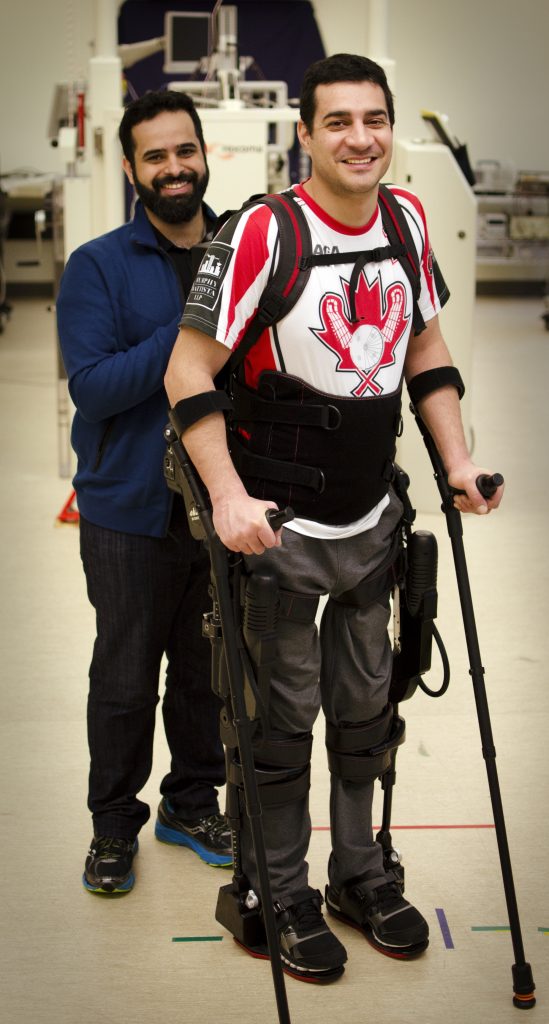
Kyle takes part in the Ekso study.
“We were really surprised with how well we kept up with the other teams,” says Kyle. “And working with the Dutch players was a really good experience.”
Kyle will be raising funds for another trip to an international floorball competition in the Czech Republic in August, and he’s part of organizing another tournament in Toronto next year.
At ICORD, Kyle has been instrumental in recruiting volunteers and participating in research. This spring he began leading a spin classes at PARC on the new fleet of arm cycles.
“We chose Kyle to lead the spin class, because he knows how to bring the best out in people,” says Megan Brousseau, a PARC study coordinator, who has known Kyle since 2009 when they met as volunteers at the GF Strong Rehabilitation Centre.
“I’ve known him as a volunteer, a colleague, and a friend, and he’s effective in all capacities of his life,” says Megan. “He’s always working to make things better for other people, and his passion is so obvious and contagious.”
By his estimate, Kyle has participated in more than twenty SCI-related studies, many of them involving ICORD researchers. He was the first in Dr. Amanda Chisholm’s study of the rehabilitation effects of using a robotic exoskeleton for walking. “It was definitely a treat to get up and walk around,” says Kyle. “It will be good to see where it goes in the future.” (If you want to try the Ekso for yourself, keep reading!)
Kyle encourages everyone to be aware of current research and to come to ICORD to see all of the technology and resources dedicated to SCI research. He adds that getting involved with the community has been one of the biggest benefits to him. “Just to have a good group of people to workout beside you and push you to move forward is really important,” he says.
Kyle would like to let you know that wheelchair floorball happens at the Lions Gate Christian Academy every Sunday from 11 A.M. to 1 P.M. and a smaller game takes place at GF Strong from 6 P.M. to 8 P.M. every Monday.
 Dr. Tania Lam and her research team are conducting a study to compare muscle activation patterns during overground walking with the Ekso suit versus treadmill walking with the Lokomat.
Dr. Tania Lam and her research team are conducting a study to compare muscle activation patterns during overground walking with the Ekso suit versus treadmill walking with the Lokomat.
Your participation will involve one visit of about about four hours to the Human Locomotion Research Laboratory at ICORD. The researchers are looking for people who:
- have had a complete SCI (C7 or below) OR motor-incomplete SCI (T10 or above) with good arm and hand strength, and
- are able to tolerate standing for at least 30 minutes at a time, OR
- are able-bodied adults in stable medical condition
If you are interested in participating or would like more information, email the research team or call 604-675-8815.

… what projects they’ll be working on at ICORD over the summer:
![]() This summer I will be doing some genotyping for the Tetzlaff lab, specifically a process called PCR, which is when you take small samples of DNA and multiply them so you end up with a whole bunch of DNA. I’m really enjoying my work so far, and I can’t wait to learn more as the summer progresses!”
This summer I will be doing some genotyping for the Tetzlaff lab, specifically a process called PCR, which is when you take small samples of DNA and multiply them so you end up with a whole bunch of DNA. I’m really enjoying my work so far, and I can’t wait to learn more as the summer progresses!”
– Maia Blomberg, undergraduate summer student, Tetzlaff Lab
![]() “I’m working in Dr. Ramer’s lab helping his Masters student, Erin, on her project involving PHD, a protein that affects neuropathic pain development. I’m very excited to be applying all the knowledge I’ve gained from my classes thus far, and looking forward to what I will learn in the next couple months.”
“I’m working in Dr. Ramer’s lab helping his Masters student, Erin, on her project involving PHD, a protein that affects neuropathic pain development. I’m very excited to be applying all the knowledge I’ve gained from my classes thus far, and looking forward to what I will learn in the next couple months.”
– Lisa Liu, NSERC undergraduate student research assistant, Ramer Lab
![]() “I’ll be continuing my research, which focuses on bowel management practices and cardiovascular dysfunction following SCI. I’ll also be volunteering at the ICORD Resource Centre to become more engaged with the SCI community. I look forward to expanding my research skill-set and exploring more of BC as the weather turns!”
“I’ll be continuing my research, which focuses on bowel management practices and cardiovascular dysfunction following SCI. I’ll also be volunteering at the ICORD Resource Centre to become more engaged with the SCI community. I look forward to expanding my research skill-set and exploring more of BC as the weather turns!”
– Vera Lucci, MSc student, Claydon Lab
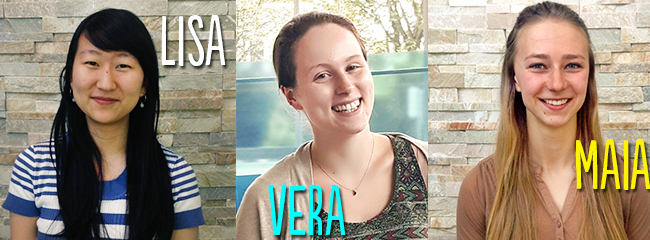

Dr. Sadeghi hopes to complete her training before returning to Canada to practice as a clinician scientist with a focus on neurophysiology, a subject she had been fascinated with since medical school. “The central nervous system gives you a good sense of who you are and what you’re capable of,” she says.
Dr. Sadeghi arrived at ICORD in 2011, after training as a medical doctor at the Iran University of Medical Sciences. She wanted to learn more about clinical science and research, and sought out Dr. Sawatzky as an advisor for a thesis on spasticity. Since then she has studying and worked at ICORD along with her husband, Mehdi Eshraghi, who is currently a Masters student with Drs. Sawatzky and Mortenson.
In 2014, she completed her degree with Dr. Sawatzky and was soon hired by ICORD PIs Drs. Ben Mortenson and Dr. Andrei Krassioukov to assist them with their respective studies.
She says her experience at ICORD has been invaluable to her training as a physician and researcher. “ICORD has been a really good opportunity for me to work with physicians and researchers I could learn from,” says Dr. Sadeghi.
Dr. Krassioukov’s experience was a particular motivation for Dr. Sadeghi, as he moved to Canada as a foreign doctor and built up a clinical practice and research career. “He understood how hard it was to work at ICORD doing research, while at the same time studying for the American medical board exams,” she say.
For Dr. Sadeghi, the support of Drs. Krassioukov, Mortenson and Sawatzky was invaluable. “You need something to motivate you,” she says. “And the people at ICORD have all been good examples for me.”
In addition to completing her Masters degree and writing the American medical school exams, Dr. Sadeghi published three papers and assisted on several studies.
“She has a wonderful manner in interacting with patients,” says Dr. Mortenson (pictured below with Dr. Sadeghi and the rest of his team). “She has demonstrated an amazing capacity to develop rapport with patients of all ages, backgrounds, and cultures.”
ICORD wishes Dr. Sadeghi the best of luck with her four-year residency and looks forward to her return as a much needed neurologist, who will be able to contribute to future research on spinal cord injury.
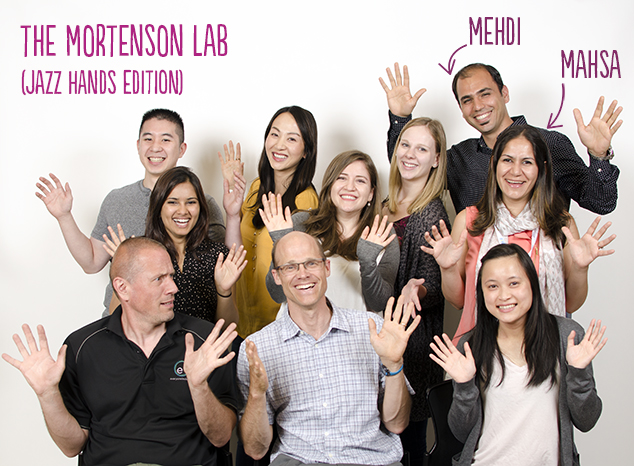

Meet Simon Liem, a former journalist who joined the ICORD admin team last year. He has an important job helping researchers with their grant applications:
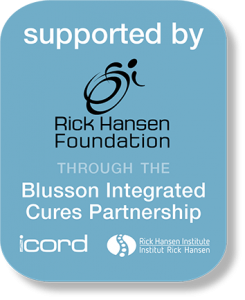 As any academic can tell you, before research happens, funding needs to be found. In the Ohio State University project mentioned above, some of the $10-million budget was very likely reinvested in finding more resources to keep that work going. Thankfully, at ICORD we have the support for this type of task with the Blusson Integrated Cures Partnership (BICP), the $20-million ten-year agreement funded by the Rick Hansen Foundation, which provides resources for research and outreach to ICORD and the Rick Hansen Institute.
As any academic can tell you, before research happens, funding needs to be found. In the Ohio State University project mentioned above, some of the $10-million budget was very likely reinvested in finding more resources to keep that work going. Thankfully, at ICORD we have the support for this type of task with the Blusson Integrated Cures Partnership (BICP), the $20-million ten-year agreement funded by the Rick Hansen Foundation, which provides resources for research and outreach to ICORD and the Rick Hansen Institute.
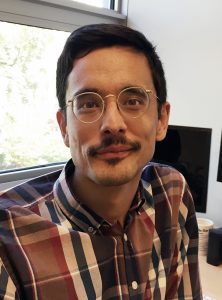 My own position is funded by the BICP. Since starting as ICORD’s research facilitator late last year, I’ve had the pleasure of working with several principal investigators. I was able to assist Dr. Krassioukov’s team with writing lay summaries for a successful Heart and Stroke Foundation grant application. My copy-editing skills were tested with the CIHR Project Scheme competition. And, among other things, I’ve set up a new funding opportunities page to keep ICORDians up to date with all of the latest funding opportunities.
My own position is funded by the BICP. Since starting as ICORD’s research facilitator late last year, I’ve had the pleasure of working with several principal investigators. I was able to assist Dr. Krassioukov’s team with writing lay summaries for a successful Heart and Stroke Foundation grant application. My copy-editing skills were tested with the CIHR Project Scheme competition. And, among other things, I’ve set up a new funding opportunities page to keep ICORDians up to date with all of the latest funding opportunities.
In addition to my work in research facilitation, I’ve worked closely with the communications teams of both ICORD and RHI, creating content for the web, social media, and this newsletter. It’s important to us that the world knows about the research happening here in the Blusson Spinal Cord Centre, and we enjoy working with the brilliant minds here to make that happen.
It has been an educational experience to see how much effort goes into getting to the stage where scientific inquiry becomes feasible, and I’ve been very grateful to have become a small part of that process. If you have any needs that you think I could help you with or suggestions for how to improve ICORD’s resources for finding funding, please let me know. I’d love to hear from you!



Did you know that volunteers at our SCI Community Resource Centre prepare summaries of scientific papers and post them on our blog? If you’re interested in what’s going on in SCI research around the world, this is a good place to look.

Help share the message of #Access4All
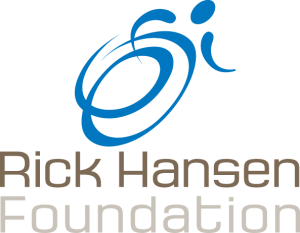 The Rick Hansen Foundation believes that everyone should be able to reach their full potential, and we know that you and all Blusson community members do too.
The Rick Hansen Foundation believes that everyone should be able to reach their full potential, and we know that you and all Blusson community members do too.
That’s why we’re inviting you to share our new #Access4All campaign through your social networks. It’s designed to highlight that people living with disabilities still face many physical barriers in our society and deserve equal access to the places where we live, work, and play.
Please watch the video and help share this important message with your social networks. Visit rickhansen.com/access4all to learn more. Together we can build a world that’s accessible for everyone!
Join SCI-BC in the Scotiabank Charity Challenge
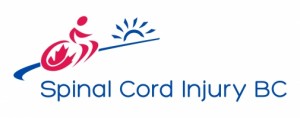
Slip on those sneakers and wheel, run, or walk in support of Spinal Cord Injury BC on June 26 in the annual Scotiabank Charity Challenge. Sign up and join the team, or donate to help SCI BC reach their goal to raise $50,000 to help people living with spinal cord injury adjust, adapt, and thrive. Register with Gill or donate to Team Walk ’n’ Rollers online.
Together we can create a healthier tomorrow through research
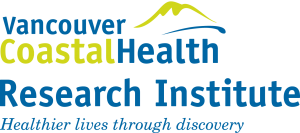
The Vancouver Coastal Health Research Institute (VCHRI) is launching a research awareness campaign to promote and support research at VCH.
As part of the campaign, VCHRI is developing a monthly community newsletter, In It Together, that will bring attention to VCH clinical trials, research studies, and the essential role of the patient participants. The electronic newsletter aims to inspire interested individuals to find out more about research at VCH and participation opportunities by visiting vchri.ca/participate. Stories will feature clinical trials and studies at VCHRI and will highlight the potentially life-changing discoveries and the important role of volunteer participants.
We encourage you to sign up at vchri.ca/InItTogether and to help connect people you know to research. Together we will create a healthier tomorrow through research–be part of the discovery.
RHI hosts successful Praxis 2016 conference
![]() The Rick Hansen Institute (RHI) hosted the Praxis 2016 conference from April 25–27 at the Fairmont Hotel Vancouver. Over 200 leaders and stakeholders in the field of SCI convened for this landmark conference focused on developing practical solutions for overcoming challenges to translating research into improved outcomes for people living with SCI. The Opening Session was a great start to this 2.5 day conference, featuring presentations from four inspiring speakers (listed below), followed by a Welcome Reception and Poster Viewing of over 45 research posters, including many from colleagues within the Blusson Spinal Cord Centre (BSSC):
The Rick Hansen Institute (RHI) hosted the Praxis 2016 conference from April 25–27 at the Fairmont Hotel Vancouver. Over 200 leaders and stakeholders in the field of SCI convened for this landmark conference focused on developing practical solutions for overcoming challenges to translating research into improved outcomes for people living with SCI. The Opening Session was a great start to this 2.5 day conference, featuring presentations from four inspiring speakers (listed below), followed by a Welcome Reception and Poster Viewing of over 45 research posters, including many from colleagues within the Blusson Spinal Cord Centre (BSSC):
Opening Plenary Session Speakers:

Praxis 2016 Opening Session Speakers. Back row, L-R: Graham Creasey (Stanford School of Medicine), Eric Marcotte (CIHR), Bill Barrable (Rick Hansen Institute), Francesco Marincola (Sidra Medical and Research Centre). Front row, L-R: Jennifer French (Neurotech Network), Rick Hansen (Rick Hansen Foundation), and Kim Anderson-Erisman (Miami Project to Cure Paralysis).
- Rick Hansen, C.C., O.B.C. – CEO, Rick Hansen Foundation; Celebrated Paralympic athlete, Man in Motion, disabilities advocate
- Francesco Marincola, MD, FACS – Chief Research Officer, Sidra Medical and Research Centre; Translational research expert, author of more than 600 peer-reviewed articles
- Jennifer French, MBA – Executive Director and Co-Founder, Neurotech Network; First woman to receive the Implantable Stand & Transfer System, Paralympic athlete
- Kim Anderson-Erisman, PhD – Director of Education, The Miami Project to Cure Paralysis; Translational research expert, SCI Hall of Fame inductee
The innovative conference model focused on moving theory into practice by employing interactive plenary sessions and working group discussions, which required engagement from all. Each of the four sessions started with brief presentations from subject matter experts who shared their experiences related to the session topic, thereby setting the stage for delegates to address the questions and issues assigned to each session. During the Closing Session, the Session Chairs highlighted insights from throughout the conference and offered recommendations on next steps. Participants also committed to take action through communicating, advocating, sharing information and engaging to accelerate the pace of translation of SCI research. Praxis 2016 Conference Chair, Dr. Graham Creasey (Stanford School of Medicine), wrapped up the conference by saying, “We’ve paused together in our journey, discussed experiences, shared stories, and come to recommendations for how we can do better. Now, it is time for us to strike out again together, with an adventurous and collaborative spirit, to press forward in improving the lives of people living with SCI”.
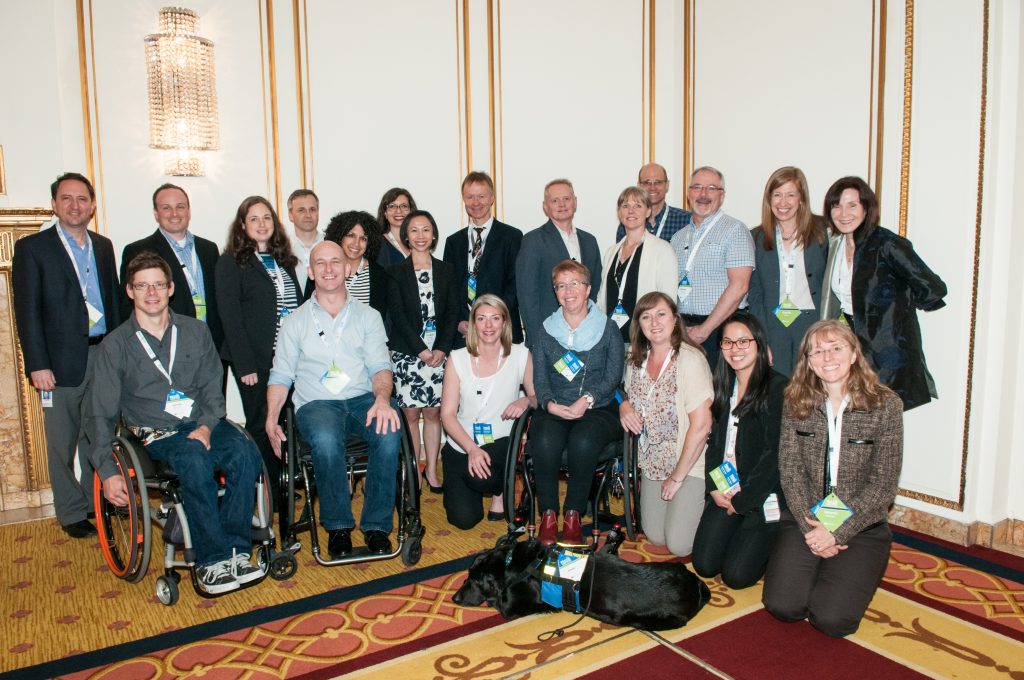
Some of the Blusson Spinal Cord Centre’s team members present at the Praxis 2016 Opening Plenary Session and Welcome Reception.
The feedback from conference delegates has been overwhelmingly positive, recognizing Praxis 2016 as a world-class event, which provided an important learning experience with compelling discussions featuring thought-provoking questions. Thank you to everyone at BSSC for their participation and contributions in helping RHI host this successful event.
An Action Committee was convened to lead the work of prioritizing and sharing actions by Praxis 2016 participants. Led by Graham Creasey and Catherine Truchon, who volunteered to serve as the primary initial contacts, and supported administratively through a secretariat at the Rick Hansen Institute, the Action Committee will function as a bridge between the work of Praxis 2016 participants and the implementation of change in the SCI research and consumer communities.
A comprehensive Praxis 2016 report will be disseminated to conference delegates and other key stakeholders in early July. Peer-reviewed publications will also be produced in relation to the conference. Visit www.rickhanseninstitute.org for updates.
 ICORD and the Rick Hansen Institute are working together to identify new treatments for SCI and apply existing treatments for other neurological disorders, injuries and diseases to SCI. Funded by the Rick Hansen Foundation, the Blusson Integrated Cures Partnership provides ten years of stable funding for several multi-year research projects as well as new faculty positions within ICORD,
ICORD and the Rick Hansen Institute are working together to identify new treatments for SCI and apply existing treatments for other neurological disorders, injuries and diseases to SCI. Funded by the Rick Hansen Foundation, the Blusson Integrated Cures Partnership provides ten years of stable funding for several multi-year research projects as well as new faculty positions within ICORD, international exchanges to encourage collaboration, research-related events (like the Annual Research Meeting and seminar series) and a consumer engagement strategy which aims to provide people with SCI and their supporters with evidence-based information about the healthcare, services and resources available to best support recovery after SCI and increase consumer involvement in the research process.
international exchanges to encourage collaboration, research-related events (like the Annual Research Meeting and seminar series) and a consumer engagement strategy which aims to provide people with SCI and their supporters with evidence-based information about the healthcare, services and resources available to best support recovery after SCI and increase consumer involvement in the research process.
We are very grateful for this generous support.
Contributors to this issue of the ICORDian:
Simon Liem, Ana Maria Oproescu, Ravina Johal, Kay Leung, Maya Pankalla, Cliff Bridges, Cheryl Niamath
Thanks
for reading this issue of the ICORDian – we hope you enjoyed it! Please subscribe and have future issues delivered to your email box. If you have any comments about this issue or suggestions for future ones, please contact us.

